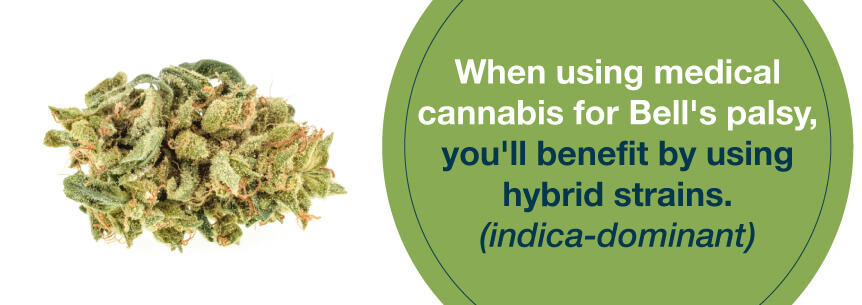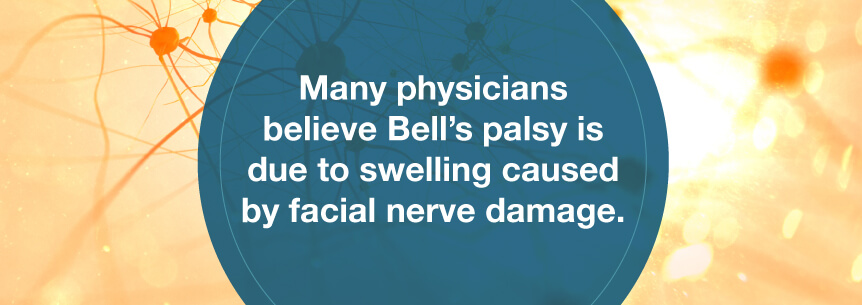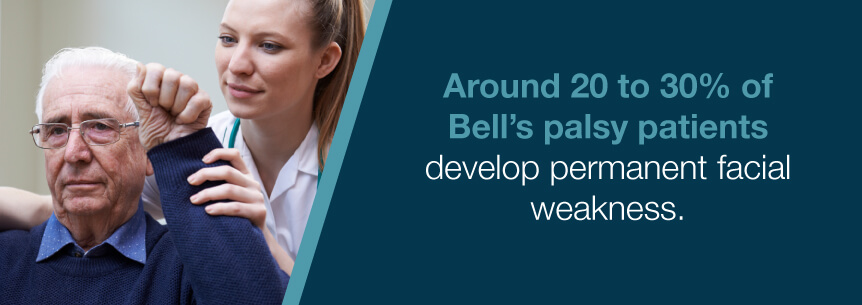Many patients who have various medical conditions find relief with medical marijuana. Although pot is not a “cure-all” drug, science touts it as a valuable treatment for curbing inflammation, chronic pain, nausea and other ailments. Now, we can add medical marijuana for Bell’s palsy to the mix.
Bell’s palsy involves facial paralysis as a result of a cranial nerve, or facial nerve, dysfunction. Due to the dysfunction of this nerve, it causes you to be unable to control facial muscles on the side of your face affected. Several conditions can cause facial paralysis, including having a brain tumor, a stroke or even Lyme disease.
Unfortunately, science hasn’t identified specific causes as playing a leading factor in the formation of Bell’s palsy. Bell’s palsy is one of the most common acute mononeuropathy conditions and is one of the most common causes of acute facial never paralysis.
Per year, nearly 30,000 to 40,000 individuals in the United States are affected by Bell’s palsy. Although many people have recovered spontaneously from Bell’s palsy, there is the chance to achieve near-normal functioning once again. Some believe a type of herpes infection known as herpes zoster could be directly involved with the formation of this condition.
In many cases, no treatment may be necessary for Bell’s palsy, as some symptoms begin to improve right away. However, some patients who are dealing with the symptoms of the condition for months at a time, it can be a degrading and frustrating time of their life. Here, medical marijuana can come into play as an excellent alternative medication.
Cannabinoids have had potential relevance clinically to treat a host of neurodegenerative disorders such as Parkinson’s disease, multiple sclerosis, and Bell’s palsy. It is of the utmost importance to relax the brain this way all stress is gone, but, first, a patient needs to learn how to ease their brain properly.
Marijuana can impact a production of new nerves and neurons in the brain, which can stimulate the grown of gross motor nerves to improve the symptoms of the condition. Also, regarding the individual’s immune system, depending on how low of a dose they take, it may enhance cell proliferation within the body.
Find A Doctor Find A Dispensary
Marijuana for Bell’s palsy can help in at least these four ways:
Here’s how it works.
Marijuana contains neuroprotective antioxidant properties to reduce free radical damage like pollution, stress and other toxins impacting nerve cell health. When your nerve cells are further damaged, it can worsen your symptoms. Even though there’s little to no research done on marijuana and Bell’s palsy treatment for neuroprotection against the condition, there’s a U.S. government patent to use cannabinoids to protect against a variety of inflammatory disease and neurological conditions.
When your facial nerve is compressed or inflamed, symptoms of Bell’s palsy may develop. Because of endless terpenes and cannabinoids, medical pot is an established anti-inflammatory. They have powerful inflammation-fighting properties. Weed is also acknowledged as being an efficient inflammation treatment in your nerve cells, associated with multiple incapacitating degenerative conditions.
Studies demonstrate the psychoactive cannabinoid, tetrahydrocannabinol (THC), as being able to reduce neural inflammation in Alzheimer’s disease-induced animal models. Treatment for your inflammation can help reduce the severity and frequency of your symptoms. But while there’s no research at the moment to prove this, patients with other disorders similar to Bell’s palsy, like multiple sclerosis and cerebral palsy, are reporting relief from cannabis and Bell’s palsy treatment.
Another common Bell’s palsy symptom is headaches, and medical weed and has been helping reduce headache pain in patients for many centuries. With marijuana and Bell’s palsy treatment, there’s been a positive response to different types of headaches. Although the herb doesn’t eliminate headaches in some cases, many patients say medical marijuana makes their pain far less, so it’s more bearable.

Aside from headaches, facial and jaw pain is a common symptom in Bell’s palsy patients. According to some research, THC in low doses makes a potent analgesic. Another common compound in medical pot is cannabidiol (CBD), and this compound has been shown to effectively relieve patients’ pain.
A significant reason to consider medical marijuana for Bell’s palsy is the herb’s ability to help with multiple associated disorders, according to preclinical research. Some conditions include:
Unfortunately, there’s not a lot of formal research currently available to inform you of the most beneficial marijuana types for Bell’s palsy. Therefore, you’ll have to experiment for yourself and work with your budtender and medical marijuana doctor to find the most suitable strains.
While you should consult a medical marijuana-savvy physician before adding this powerful herb into your Bell’s palsy care strategy, here is a small list of strains that may help your symptoms:
While this isn’t an exhaustive list of medical cannabis for Bell’s palsy strains, it will get you started while you search for other potential strains to relieve your symptoms.

When using medical cannabis for Bell’s palsy, you’ll benefit by using hybrid (indica-dominant) extracts, tinctures, concentrates, cannabutter, vaporizers and teas. Here’s what you can expect for each method:
Learn more about the methods of taking medical marijuana here.
Now you are armed with cannabis and Bell’s palsy treatment information to provide you with relief from your symptoms, depending on the strain and dose. All you need to do now is search for a cannabis dispensary or work with a marijuana-certified physician and get your medical marijuana card and recommendation for the medicinal herb.
Find A Doctor Find A Dispensary
Bell’s palsy is a disorder affecting the muscles of your face, causing it to become paralyzed and weak. It only affects one side of your face and makes it stiff or droop.
While anyone can get Bell’s palsy, it tends to affect those who are recovering from a viral infection or have diabetes. Usually, the symptoms you experience are temporary.
Trauma to your seventh cranial nerve results in the development of the condition. When it occurs, it may seem as though you’re having a stroke. However, strokes affect not just your facial muscles, but also cause muscle weakness in other areas of your body as well.
Many physicians believe Bell’s palsy is due to swelling caused by facial nerve damage. Your facial nerve passes through a bony, narrow area in your skull. If it swells even slightly, it pushes against the hard surface of your skull, affecting how your nerve works.

Researchers also believe Bell’s palsy develops because of viral infections. In fact, there’s evidence a large number of cases are due to the herpes simplex type 1 virus.
Sir Charles Bell made a description in 1821 of the facial nerve anatomy and how it’s associated with this condition bearing his name. Earlier doctors, like Stalpart van der Wiel, however, described peripheral facial nerve palsy. While you can trace citations of facial nerve disorders back to Hippocrates, it was Persian physician Razi in the 9th century who came up with the first complete description.
Bell’s palsy symptoms may develop a couple of weeks after you get an ear or eye infection or a cold. They can come on suddenly, and you may wake up with symptoms one morning or when you try to eat or drink something.
You may not be able to open or close the eye on the side affected, and in rare cases, it might impact both sides of your face. Some other Bell’s palsy symptoms include:
If you notice any of the symptoms, call your physician promptly. Don’t ever try to make your own diagnosis of Bell’s palsy since these could also be symptoms of a different serious condition, such as brain tumor or stroke.
Typically, those with Bell’s palsy have a good prognosis. However, the extent of the damage to your nerve determines the breadth of your recovery. Rehabilitation time varies, and your improvement can be a slow process. Chances are, whether you receive treatment or not, you’ll start getting better within a couple of weeks and recover completely, getting back to your regular functioning in a few months.
But, for some individuals, symptoms could last longer. Symptoms have never completely gone away in a few cases, and in rare cases, the individual developed the condition again either on the opposite or same side of their face.
Bell’s palsy can bring on various complications, depending on how much nerve damage you have. Some complications may include:

In addition to this, a study reveals a difference in psychological status between patients with bipolar disorder and healthy people. It shows personality factors and psychological distress closely linked to facial paralysis severity.
As a facial paralysis patient, your emotional well-being may be affected, leading to low self-esteem, frustration and even depression. As a result, having Bell’s palsy can negatively impact your overall quality of life.
Bell’s palsy facts reported by the American Family Physician (AFP) include:
Physicians make a Bell’s palsy diagnosis based on clinical presentation, which includes not being able to move the muscles on the side of your face affected and a distorted facial appearance. They also rule out other potential reasons for your facial paralysis. Doctors don’t have a specific lab test they use to confirm a diagnosis of Bell’s palsy.
Typically, a doctor examines you for lower and upper facial weakness. Most of the time, the weakness is only on one side of your face or isolated to your mouth, forehead or eyelid. You may receive an electromyography (EMG) test to confirm nerve damage presence and determine the extent of severity and nerve involvement.
If you undergo blood tests, it’s usually to help identify any concurrent conditions, like infections or diabetes. Computed tomography (CT) or magnetic resonance imaging (MRI) scans help to rule out any other structural causes of facial nerve pressure.
Currently no medications can stop Bell’s palsy from developing. You may receive acyclovir or other antiviral medication if shingles or herpes simplex 1 virus trigger your symptoms. Side effects of acyclovir may include:
You may receive a short course of prednisone or other corticosteroids to help decrease facial nerve swelling and possibly shorten your symptoms’ duration. Side effects of prednisone may include:
Other than this, your physician will recommend you carefully protect your eye on the side of your face affected. You may need to wear an eye patch if you can’t blink. You may need eye drops to moisten your eyes if you’re tearing less than average.
Your healthcare provider may also recommend facial muscle massage therapy. If your symptoms show no improvement, in rare cases, they may recommend surgery to help reduce facial nerve pressure.


Please allow us to access your location to find local dispensaries.
VIEW ALL DISPENSARIES ➔